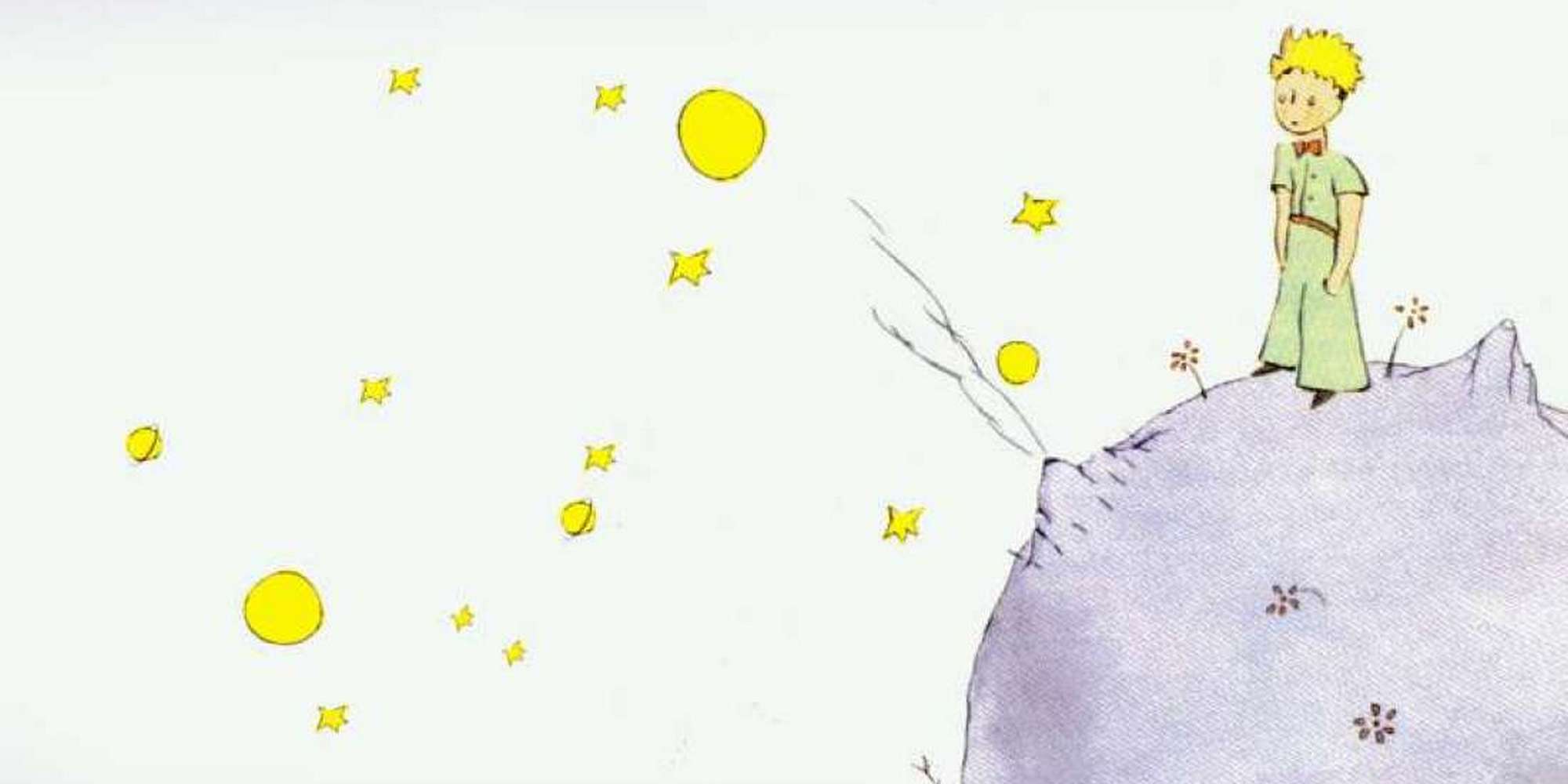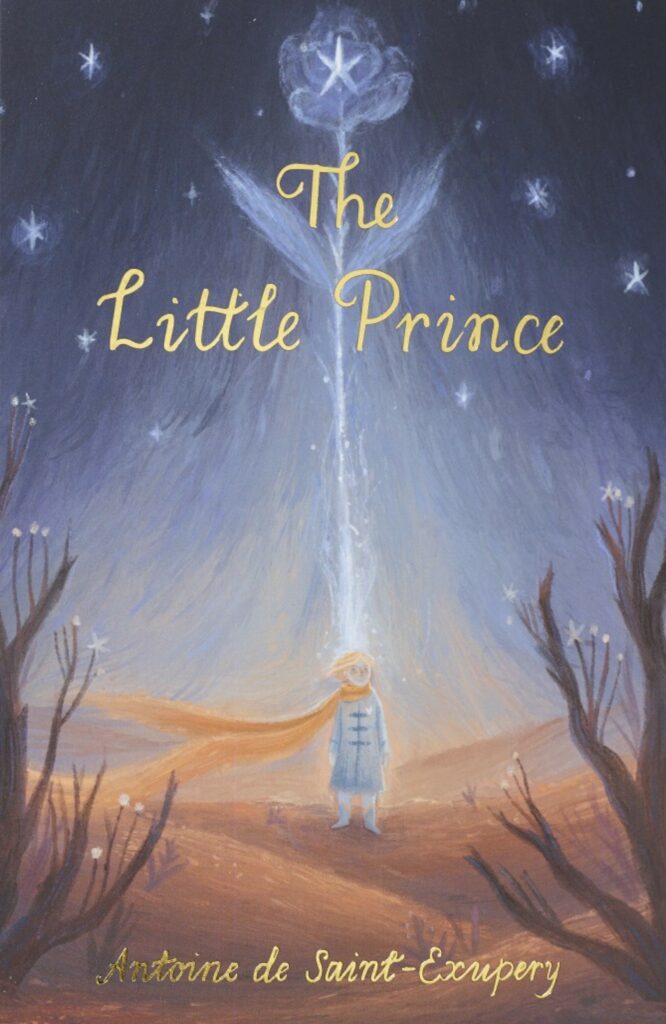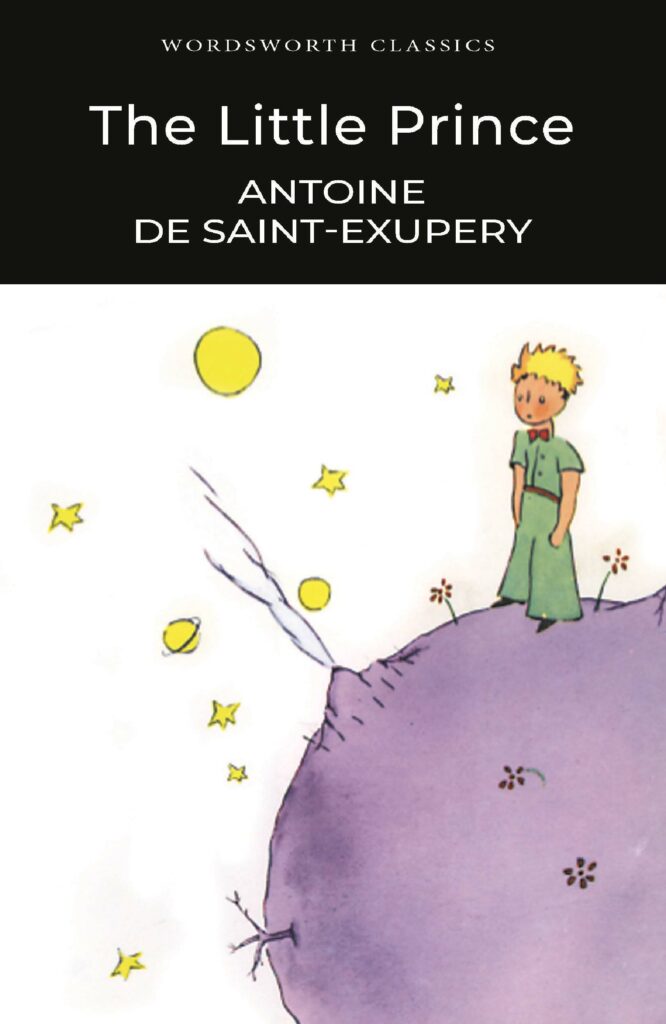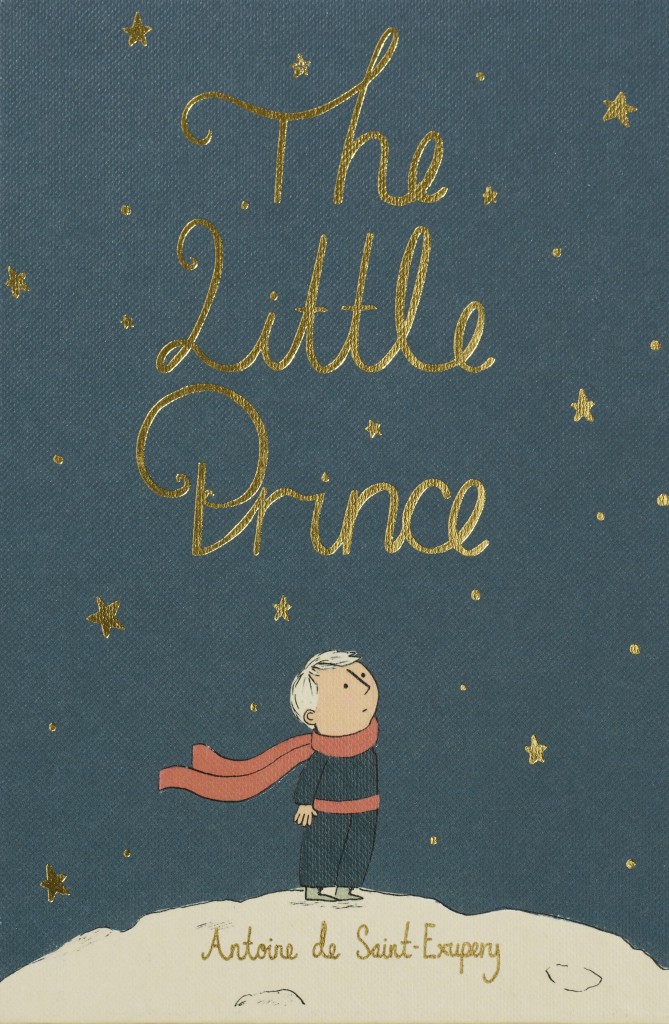
Sally Minogue looks at The Little Prince
How do we read a fable? Sally Minogue ponders the mysteries of ‘The Little Prince’
‘As I write, highly civilised human beings are flying overhead, trying to kill me’: thus George Orwell famously opened his 1941 essay ‘England Your England’. Antoine de Saint-Exupéry, the author of The Little Prince (1943) and of iconic essays on the romance of flight, takes us in those essays up to the level that Orwell sees only from below – the level of the flyer, of being in flight, above the world, in not just another element but a completely different element, apparently detached from the toils of the world. Yet The Little Prince is told from the viewpoint of such a flyer brought down to earth, grounded. Only his mysterious companion and revenant from another planet, the eponymous Little Prince, takes him and us into flight again – the flight of the imagination.
Le Petit Prince: the original title reflects both the glamour of the French language and that tiny poetic frisson added by alliteration. For the English reader, and for readers far and wide, both the title and the work have exerted a pull far in excess of the book’s brevity. It remains, for Wordsworth, one of its best sellers, but this reflects only what is the case in general. Saint-Exupéry’s slender work is also one of the world’s most widely translated books (between 250 and 300 official translations); in the 73 years since its publication, most estimates agree that it has sold 140 million copies worldwide, and has averaged sales of 2 million copies annually. Let’s hope his legatees are enjoying the fruits of his writing labours since he conspicuously didn’t. He disappeared on a reconnaissance flight in 1944, under Allied auspices, just a year after its publication. So why has this work continued to have such resonance?
The Little Prince seems to have been marketed to adults and children alike right from the start. At a time when there was no crossover fiction, it set its own readership. There were perhaps precedents in fables and fairy tales; but this was a fable for the 20th century. On the one hand, children could both identify with the small being at the tale’s heart, and marvel at a world of fantasy far removed from any quotidian reality. On the other, adults could find weighty meanings in the encounters the little prince recounts as he sojourns between worlds, whilst at the same time allowing themselves to be charmed back to childhood by this wise but innocent infant. What is key to the world Saint-Exupéry creates is that it is entirely free of rational considerations. Both protagonists have dropped from the sky; but the narrator has ditched his plane in the desert, he is on and of the world, whilst the sweet-natured fellow he encounters has dropped – from an asteroid. Furthermore, that asteroid is so small that just by moving his chair a few inches the little prince could see a new sunset. In the meeting of the narrator – let’s call him St-Ex – who has ditched his plane in the Sahara desert, and the little prince, who has dropped there through time and space from his tiny asteroid, comes an intersection of two worlds, the one governed by the laws of nature, and the other determined only by the limits of imagination. But the narrator is only too ready to leap into that larger world; he has established for us in the first chapter his contempt for ‘grown-ups’: ‘I have spent a lot of time with grown-ups. I have seen them at very close quarters which I’m afraid has not greatly enhanced my opinion of them.’ (11) In the little prince he finds a kindred spirit. Each of the little prince’s encounters with the inhabitants of the various planets he visits is punctuated by the judgement: ‘Grown-ups are really very odd.’ And his worst admonition to St-Ex, concerned at that point with trying to mend his plane engine and so ‘busy with serious matters’, is to say, ‘You talk just like grown-ups’. (32)
So the story not only takes us into the world of the imagination, it announces the profound value of that world. Beside it the concerns of adults, exemplified in some of the little prince’s planetary encounters with railway signalmen, merchants, lamplighters, kings, are shown to be lamentably silly. His meetings with animals and plants, however, bring him greater wisdom, usually in the form of a fable. The snake, who is ‘more powerful than a king’s finger’ avers ‘Whomever I touch I send back to the earth from which they came’. (70) But the child is exempt, for the moment, from this veiled threat, in part because he doesn’t recognise it, and in part because the snake sees in him a simple fellow creature – ‘“You are pure and innocent and come from a star”’ – and feels sorry for him. The fox, who begs to be tamed, teaches ‘“For what you have tamed, you become responsible forever”’. And again, he leaves with a riddle: ‘“What is essential is invisible to the eye.”’ (82)
This reminds us of the box St-Ex draws at the little prince’s first request for a sheep, and of the first illustration of the book, which may look to grown-ups like a hat, but is in fact a picture of a boa constrictor digesting an elephant. As long as we use our imagination, we can make visible the invisible, we can see not only a sheep but the grass which will feed him, all within the drawn box. But if we stick to rational considerations, we see only the empty box, which is only a drawing at that. It is the little prince’s imagination which saves the fallen pilot:
The well we had reached did not look like the usual wells of the Sahara. Sahara wells are simple holes dug in the sand. This one looked like a village well. But there was no village here and I thought I was dreaming.
“How strange,” I said to the little prince, “everything is ready: the pulley, the bucket and the rope…”
He laughed, touched the rope and set the pulley working. (92)
Thus St-Ex is saved by the water the little prince has conjured, and the prince too has his heart’s thirst slaked by it: ‘I raised the bucket to his lips. He drank with his eyes closed. It was as sweet as a festival treat. This water was something entirely different from ordinary nourishment. It was born from the walk under the stars, the singing of the pulley and the effort of my arms. It was good for the heart, like a gift.’ (93)
In the end this is a sort of love story, in which two frail beings, the downed pilot and the wandering infant-prince who has left behind all he knows, share their short time together isolated from humanity and finding sustenance in each other. Soon after the little prince has accused the pilot of sounding like grown-ups, he spills out his sense of loss of the one rose he has left behind on his asteroid, which he fears is in danger of being eaten by a careless sheep:
He could say no more because he was overcome with tears. Night had fallen. I had dropped my tools. I couldn’t have cared less about my hammer, my bolt, thirst, or death. There was on a star, a planet, mine, the Earth, a little prince to be comforted! I took him in my arms and rocked him gently. (34)
To comfort him he promises to draw ‘“a muzzle for your sheep . . . I shall draw you a fence for your flower . . .”’. Thus each saves the other by an act of the imagination which is also an act of love.
And if this is at heart a story about love, it is also one of parting. St-Ex mends his plane and is to return to the world of men; the little prince, on the anniversary of his arrival on earth, is also going home. I will leave readers to inhabit those few last sorrowful chapters themselves. For this is a book which creates a unique relationship with each reader, whether child or adult. The world it creates may be child-like, but it is in no way childish. For myself, on re-reading it, I was reminded of Proust, not in any pretentious way (though there are many pretentious comparisons and claims that have been made about Le Petit Prince) but because it is centrally about the creation of a childhood world, a world of innocence which already has in it the apprehension of its own disappearance. When the older Narrator of the first volume of À la Recherche du Temps Perdu tastes the tea-soaked madeleine, ‘an exquisite pleasure had invaded my senses … at once the vicissitudes of life had become indifferent to me … – this new sensation having had on me the effect which love has of filling me with a precious essence. … I had ceased now to feel mediocre, accidental, mortal. Whence could it have come to me, this all-powerful joy?’ Eventually, he realises that the taste of the madeleine has transported him back to that period of his childhood, in Combray, with which the novel begins and which centres on his going to bed as a child, at the heart of which is his love of his mother and her saying goodnight to him before sleep. Yet when he has earlier described these bedtimes, they are already instinct with loss. For whenever he imagines her final goodnight, it is in the knowledge that once it is made, he has lost her for the rest of the night – except on one magical occasion, recounted many pages before the madeleine episode, when she stays with him all night, the one time it will happen. Here is the heart of the ‘irreplaceable joy’ he finds through memory, a joy which in the original experience was already shot through with the fear of its loss.
This is, for me, what creates the underlying atmosphere of sadness in The Little Prince; as he gravely recounts his various encounters to St-Ex, the little prince knows already the loss that is to come, a loss that in this case takes the adult narrator by surprise but has always been there for the child. It is a fable that reverses that tug of the heart that we feel as adults when we see a child gradually move away from the happy innocence of their first few years; here the adult has been given the innocence of the child, and the child consoles the adult for his own incipient loss – and consoles the reader too:
“And when you are comforted (time soothes all sorrows) you will be happy to have known me. You will always be my friend. You will want to laugh with me. And from time to time you will open your window, just for the pleasure of it . . . And your friends will be astonished to see you laughing whilst gazing at the sky.” (100)
Biography/ Further Reading
Antoine de Saint-Exupéry wrote several prose works before the different genre of Le Petit Prince. These all recount in one way or another his experiences as a pilot, some in the form of fiction, some memoir. He first trained as a pilot for the French Air Force in the early 1920s, then flew the night mails in hazardous circumstances in North Africa and South America. He was an accredited Press correspondent in the Spanish Civil War, reporting on it for several French newspapers. At the start of World War Two he flew reconnaissance missions, and after a brief exile in America after the fall of France, returned to reconnaissance flying in 1944 (on one of which flights he was killed).
His principal works are Courrier Sud, 1929 (Southern Mail); Vol de Nuit, 1931 (Night Flight); Terre des Hommes, 1939 (Wind, Sand and Stars) and Pilote de Guerre, 1942 (Flight to Arras). My own copy of the combined Wind, Sand and Stars and Flight to Arras was published by Picador in 1987, translated by Lewis Galantière. Le Petit Prince was his final publication in his lifetime, published first in English, translated by Katharine Woods, and shortly afterwards in French, both in New York by Reynal and Hitchcock (1943). Gallimard published the first edition in France, once France was liberated in 1945. There was a further work published posthumously, Citadelle, 1948 (The Wisdom of the Sands), written in Saint-Exupéry’s final months, when reputedly the Americans whose command he was under tried to prevent him from flying, considering him to be a danger to himself and others.
The prose of these works is highly lyrical, sometimes problematically so, though perhaps it would read better in French. The world he depicts is almost entirely masculine. The undeniable bravery of the pilot, even one involved in what might seem to a modern reader the quotidian task of delivering the mail, is made into something greater than itself. The heady mixture of danger, spirituality and male bonding over a downed engine or under the night stars of the Sahara, can smack uncomfortably of the politics which he nonetheless very clearly and heroically fought against.
For further information see Stacy Schiff, Saint-Exupéry: A Biography (New York, Alfred A Knopf), 1995
Marcel Proust, Remembrance of Things Past (C. K. Scott-Moncrieff translation), (London, Chatto and Windus), 1966. Proust’s novel sequence was published in France between 1913 and 1927. Saint-Exupéry is not noted for his academic prowess, but as a significant writer and winner of many key national prizes, including the Prix Femina and the Grand Prix du roman de l’Académie Francais, he would surely have been familiar with the great French work of fiction of his time.
George Orwell, ‘England Your England’ in The Lion and the Unicorn: Socialism and the English Genius, 1941
Books associated with this article

The Little Prince (Exclusive)
Antoine de Saint-Exupery

The Little Prince
Antoine de Saint-Exupery
